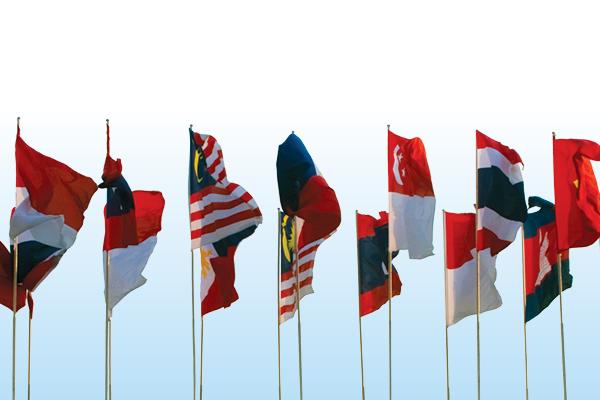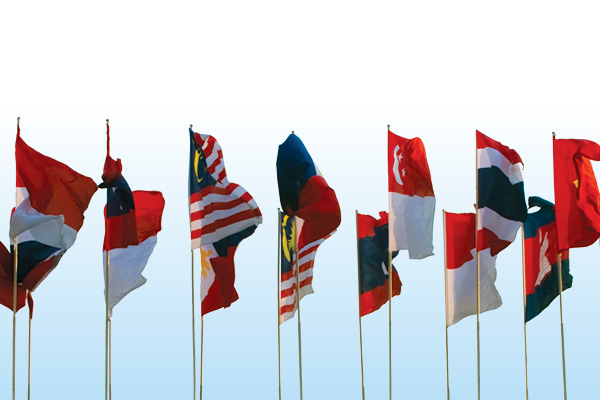
The ASEAN Economic Community (AEC), an idea years in the making, aims to integrate Southeast Asia’s diverse economies, a region with 620 million people and a combined gross domestic product of $2.4 trillion. The AEC is defined by four pillars: Creating a single market and production base, increasing competitiveness, promoting equitable economic development, and further integrating ASEAN into the global economy. To synergise the region’s markets and production hubs, this would entail the free flow of goods, services, investments, capital, and skilled labour. We look at how companies in the region, as well as law firms, are preparing for the AEC.
Back to topThe AEC cometh
Ten countries. An area of 1.7 million square miles, teeming with natural resources. A population of approximately 625 million people, predominantly young, making up almost 9 percent of the number of human beings on the planet. The sheer numbers indicate that the countries making up the ASEAN region – combined, the world’s seventh largest economy and one of its fastest growing – should be an economic powerhouse in its own right, but the truth of the matter is that development is at vastly different stages across the 10 member-states.
Slated to come into force at the end of this year, the ASEAN Economic Community (AEC),is expected to harness all this unquestionable potential. The AEC aims to create a single market with a freer flow of capital, services, products and skilled workers across borders. Within a decade or so, there are hopes that it will rival the European Union, as the ASEAN becomes fully integrated as a global economic bloc. And as the economic pie grows, so should the advantages for all member-states. Businesses across the board are expected to become more competitive on cost, thus helping to propel the region to the next level of development.
Azman Jaafar, a partner with RHTLaw Taylor Wessing in Singapore, says he believes that the manufacturing sector should reap the most benefits from the AEC. “There is hope that the services will see growth as well, but we don’t expect member-states to open up the services sector so quickly,” he says. “Singapore and Malaysia are way ahead in opening up their markets. If you look at Indonesia, a lot of services and the B2C space are all closed or subject to local participation. What will affect both manufacturing and services sectors will be the fact that human capital may not flow as freely as contemplated under AEC.”
Lack of awareness is one of the immediate challenges that the AEC faces. While larger companies appear well-set for the community, small and medium-sized enterprises (SMEs) that generate around 90 percent of ASEAN jobs and between 30 to 50 percent of GDP are not on board yet. And then there is preparation: A recent survey by the Asian Development Bank and Institute of Southeast Asia Studies found that less than one-fifth of ASEAN businesses are AEC-ready. “Domestic companies need to strengthen their internal processes so they can support a regionalisation expansion drive,” says Jaafar. “Companies must create the necessary structures that can support cross-border operations and develop more flexible capabilities that can facilitate expansion across cultural barriers. Most important of all, these companies need sufficient financial resources to ensure that the pre-investment preparatory work can be completed prior to the expansion. Many domestic companies do not have budgets for professional advisors to assist them in their work. Without adequate resources being made available, domestic companies will be undertaking huge risks without ample preparation.”
But it’s not just companies that are preparing for the advent of the AEC. Law firms are too, as economic integration is expected to give rise to the need for legal and regulatory challenges that require professional advice. “We have seen the emergence of regulatory compliance as a major concern for regulated sectors within AEC,” says Jaafar. “The AEC harmonises standards and removes trade barriers. It doesn’t harmonise the laws applicable to investors.”
He adds that with cross-border work on the rise, dispute resolution work can also be expected to increase, noting that the firm’s transactional teams also expecting to work more closely with RHTLaw’s ASEAN Plus partner-firms within the AEC, covering FDI laws and supporting clients in corporate/ M&A work. “Today, everything we do or advise, and any collateral we prepare, are all done with the view of delivering the work within ASEAN and beyond,” says Jaafar.
There is no doubt, however, that the next few years will be exciting for the region. “China is cooling down and India is heating up,” says Jaafar. “We believe that rivalry and competition from China and India will drive the ASEAN member-states to push the AEC agenda. Member- state compliance may not be 100 percent, but it would be high enough to bring about a positive impact. In particular, the CLMV countries [Cambodia, Laos, Myanmar and Vietnam] are fast coming up.”
He also observes that opportunities will be generated as ASEAN member-states seek to get connected. “Many of the ASEAN states are maritime states, and connectivity presents a challenge,” says Jaafar. “The growth of the AEC in the first few years will see a huge amount of capital expended on transportation, communications and technology. The sheer challenges here may be enough to drive the growth of the region for the years to come.”
Back to topSingapore
Singapore is the strongest hub for trade and investment in ASEAN: Hundreds of MNCs today use the city-state as their regional headquarters, and the Singapore corporate entity is a popular one in the ASEAN region, being often used as a vehicle of choice for regional transactions.
“Singapore has been a strong proponent of free trade and is a party to numerous free trade agreements and economic partnership agreement with major economies in the world,” says Chia Kim Huat, regional head of the corporate and transactional practice at Rajah & Tann. “Given our relatively open economy, Singapore is expected to play a pivotal role in pushing for freer flow of trade, services, capital and investments among the AEC nations.”
Chia says that while AEC is intended to benefit companies across the board, it is with resources to deploy across the region are more prepared than smaller ones and will therefore benefit more from the AEC.
“These would include companies with manufacturing bases in the region, traderelated services, financial and professional services,” he says. “Singapore-based manufacturers and traders can look forward to tapping opportunities in ASEAN, including the sourcing of lower-cost supplies and bigger markets for their products.”
According to Eugene Lim of Baker & McKenzie, Singaporean companies that traditionally target the domestic market will likely need to reconsider their strategy and look to expand their ASEAN footprint: “If not properly positioned, many of these solely domestic-focused companies risk being marginalised in a post-AEC environment.”
Law firms, meanwhile, remain busy. “While trade tariffs have substantially been removed for most goods, non-trade tariffs remain high and there are also substantial barriers to trade-related services,” says Chia. “We have recently strengthened our trade practice and are equipped to advise clients on trade-related issues across the region, including transfer pricing, anti-competitive trade policies and so on.” Additionally, clients require advice on strategic acquisitions and investments, and supply chain integration.
Back to topMalaysia
Malaysia has been facing a fair bit of economic headwinds of late. Slumping energy prices have cut its oil and gas revenues; the ringgit has dropped to six-year lows against the dollar; foreigners have turned net sellers of Malaysian equities; and the country’s previously successful IPO market has now all but stalled.
In the midst of this, the AEC appears more as a distraction than something that companies are actively aiming for. “Publicity on the AEC has been very limited and while some big companies may be aware of the opportunities, the smaller ones may have little knowledge,” says Lim Jo Yan, partner and head of the corporate and commercial practice group at MahWengKwai & Associates (MWK).
Still, lawyers expect a positive impact on both inbound and outbound investments, including M&A. “Malaysia is focusing on developing services, and the AEC will likely impact the healthcare, education, financial support services – including legal and consulting services – logistics and creative sectors,” says Jeff Leong, founder and senior partner of Malaysian law firm Jeff Leong, Poon & Wong (JLPW).
Lim recommends local businesses need to be prepared for the advent of the AEC. “Malaysian companies must inevitably prepare for more cross-border transactions, which involves understanding of different legal and regulatory frameworks and access to financial markets, freight and forwarding, immigration and manpower requirements,” says Lim. “Some Malaysian companies in the agriculture, airlines, banking and telecom sectors seem to have more awareness of the AEC’s potential. Malaysian companies should be better informed of low-cost manufacturing bases, with ample manpower resources of business opportunities or expand their current base here. Companies will have to adequately prepare themselves in terms of capital, manpower, technology, business strategy and even the mindset to focus on opportunities in the AEC.”
Leong notes that Malaysia has been exporting its services talent pool to Singapore. “With the AEC, it will be an opportunity for Malaysian companies to rapidly deploy talent across ASEAN to manage and integrate their businesses,” he says. “Cross-border business flow and the demand for professional services to support companies in ASEAN will increase.”
He adds that licensing and regulatory issues such as competition, labour and immigration work visas often crop up in his firm’s work, and this will not diminish with the AEC. “We and our regional affiliate offices have been assisting in M&A transactions as foreign investors buy up groups of companies in the logistics, education, infrastructure and manufacturing sectors across the region.”
For Lim, legal and regulatory issues that companies are currently grappling with generally relate to ensuring compliance with the existing laws of individual countries for cross-border investments and transactions. “In extreme cases, arbitration services could be required,” he adds.
In 2010, Malaysia launched its ambitious Economic Transformation Programme to address lacklustre private and foreign investment in the country and to jump to high-income status within a decade. The programme, aiming to generate $444 billion in investments and raise annual per-capita income to $15,000, has been fairly successful at the halfway stage: private investments rose at a steady 11 percent to 146.1 billion ringgit ($41.11 billion) in 2014, up from 131.7 billion ringgit a year ago.
“Malaysia adapted its economic transformation programme in 2010 as part of its efforts to become a developed country by 2020,” says Lim. “The impact of the AEC on inbound deals could also be viewed in this context and the current Malaysia Plan. Investors should be aware of record private investments; fiscal reforms; liberalisation of rules governing foreign investors, initial public offerings and property purchases; and significant infrastructure investment.”
Leong of JLPW says he expects more M&A transactions in Malaysia as foreign investors buy up Malaysian companies with good talent pools to help consolidate and manage their various operations across ASEAN. “FDI and M&A transactions are of necessity long term, relational and incomplete. It is the relational part that needs a stronger focus, and regular monitoring,” he says. “Investors will do well to understand the diverse cultures and religions in the greater ASEAN region.”
All told, Lim of MWK does not expect the AEC to take off in a fiery manner. “It will take time for the AEC to evolve and in the first one or two years the initial hiccups need to be redressed,” he says. “The ASEAN governments may need to do some high-profile window dressing to bring the general public’s attention to the possibilities of the AEC. The next two years of Malaysian business life will be dominated by Malaysian politics, and companies will react to potential political uncertainty rather than the AEC per se.”
Meanwhile, Leong says he is looking forward to busy months ahead as Malaysian companies deploy their cross-border strategies to seize opportunities. “Many are already familiar with our neighbouring countries and the weakening domestic economic conditions in Malaysia will spur Malaysians to venture further afield,” he says.
Back to topThe Philippines
According to Albert Vincent Y. Yu Chang, special counsel with SyCip, Salazar, Hernandez & Gatmaitan, the AEC is expected to boost the bullish economy of the Philippines. “From a Philippine perspective, the boost may come in the form of more foreign direct investments, increased efficiency and competitiveness of Philippine businesses, better access to talent, capital and other resources,” says Chang. “Government programmes and policies are focused on the following as ‘growth sectors’: manufacturing, agroindustry, tourism, information technology and business process management, logistics, and construction. In addition, business leaders see opportunities for growth in retail and property sectors, among others, following the ASEAN integration.”
He notes that larger Philippine companies continue to evaluate expansion and trading opportunities in the ASEAN region and also seek to maintain and strengthen their positions in the local market by way of strategic M&A and other expansion. But many of the country’s SMEs are focused on the domestic market and are currently not positioned to become regional players due to various factors, such as size limitations, limited access to capital, or market forces in specific industries. “These issues may be addressed by increased awareness and government and industry support,” says Chang.
Since the establishment of the AEC is expected to cause an increase in both outbound and inbound FDI, Chang says he expects to see foreign ownership and tax issues to become a more common area of discussion. “In some ASEAN countries, including the Philippines, foreign equity ownership in businesses is limited to certain percentages, and in some cases, entirely prohibited,” he says. “As to tax issues, the Philippines, under current tax laws, imposes one of the highest corporate income tax rates in the region.”
Chang expects that foreign investors will find the Philippines attractive but legal constraints, such as foreign ownership restrictions, may discourage them from pursuing opportunities in the Philippine market. “Policymakers in the Philippines are aware of these restrictions and other issues surrounding the establishment of the AEC,” he says. “It is possible that some of these restrictions and measures will be relaxed over time. Investors who would like to be well-positioned in the Philippine market may miss opportunities if they wait for these restrictions to actually relaxed.”
Back to topVietnam
Vietnam got a massive boost at the end of June after its prime minister approved the scrapping of a 49 percent foreign ownership cap across many listed firms in one of the country’s boldest economic reforms yet. Although some sectors will remain restricted, the plan is to step up reforms to the $184 billion economy.
To add to this, the AEC is expected to provide more impetus for economic growth. “The AEC will probably increase foreign investment into Vietnam because investors can use lower-cost labour via their investment in Vietnam and export to their desired markets taking advantage of AEC trade liberalisation,” says Vo Ha Duyen, chairperson of Vilaf. “Many experts predict that Vietnam will be among the two or three ASEAN countries that will most benefit from AEC thanks to this possible inward flow of investment.” However, she notes that preparation is key for companies. “SMEs that are not well-prepared may face more fierce competition and thus difficulties, especially in terms of technology, management, marketing, and the retention of highly skilled workers,” she adds.
Vo notes that Vietnam is also introducing significant changes to its corporate laws, and real estate business laws with a view to liberalise investment and simplify investment procedures and conditions. “Lawmakers have eventually reached some agreements on the basic principles to deal with longlasting confusions about legal rights and obligations of a local enterprise in which foreign investors have acquired some equity interest, and how foreign investment and real property ownership rights should interact,” she says. “The new laws also allow personal ownership of residential real properties in Vietnam without the requirement for residency or work permit.”
As a result, Vo says she is seeing more M&A transactions in all sectors as well as increased potential direct investment in real property projects and other infrastructure and development projects. There is also a move towards reviving dormant BOT power projects and starting new ones. The government is aggressively pursuing a plan to equitise some hundreds of stateowned enterprises, while banks continue to restructure and consolidate.
Vo observes, however, that “while the regulatory changes are intended to be more liberal to investors, changes can cause some uncertainty and dynamics, which may make it more difficult to manage legal issues affecting deals and investments in the short term.”
Back to topIndonesia
Indonesia’s value proposition as an investment destination is clear. It is the ASEAN’s most populous nation, and its economy has been gaining strength – it now accounts for about 40 percent of the region’s GDP. On top of that, the country has a growing middle-class with rising discretionary spending, making it a target for MNCs across a range of industries. “Indonesia actually could enjoy many of the benefits of being in the AEC as it is the largest country and economy in the region,” says Andrew Sutedja, managing partner of Sutedja & Associates. “However, many challenges still remain; for instance, an uncertain foreign investment policy, corruption, and a complicated bureaucracy.”
He notes that the biggest impact is likely to be felt in the areas of import and export, the financial sector, agriculture, health and labour. However, as in other countries, preparation hasn’t been ideal. “In general, many Indonesian companies – in particular SMEs – are not ready and there are many areas for improvement,” says Sutedja. “One of the areas is producing quality, competitive human resources. Another area of potential problems is the uncertain government policy when it comes to foreign employees in Indonesia.”
That a proposed integrated single-window policy on investment laws and process has not been settled yet is one of the major issues that Indonesian companies face, according to Sutedja. “Constant changes and uncertain policies on investments is jeopardizing Indonesia’s competitiveness among other countries in ASEAN,” he adds. “Our firm is actively contributing in many areas, such as publishing articles in various media, conducting panel discussions and seminars, and providing positive feedback to the government in order to resolve these uncertainties. The written laws are sometimes open to multiple interpretations and are thus not often clear. We are always consulting with the relevant authorities to make sure the written laws are interpreted correctly.”
While Sutedja notes that the AEC could boost investment to Indonesia, there are a number of things foreign investors should be aware of. “First of all, foreign investment is limited under the Indonesia’s Negative Investment List, which means not all business sectors are open for foreign investments. Secondly, Indonesia is facing political instability, thus making investors adopt a wait-and-watch approach. As such, the impact of the AEC is dependent on the government’s policies, the reform of the bureaucracy, and the creation of a stable political environment.”
Back to topThailand
As part of its preparations for the AEC, Thailand is integrating government agencies’ databases into its National Single Window (NSW) to create a full one-stop service to traders and also facilitate crossborder trade. In turn, the NSW will be further linked to similar systems in other ASEAN countries within the ASEAN Single Window. The latter is one of the aspects of the AEC that will require the expertise of legal professionals, says Cynthia M. Pornavalai, partner with Tilleke & Gibbins, as it “would require a thorough understanding of documentary requirements and the rules of origin.”
Regarding trade in services, legal professionals would likely be required to advise on levels of foreign equity participation in particular sectors, she adds, and in relation to financial services, legal professionals may also be asked to advise on what financial services and products could be launched in a specific ASEAN country. “As trade in services is gradually being opened up, legal professionals will also likely advise on the progress of liberalisation,” she says.
She notes that Thailand’s SMEs are just beginning to catch on with regard to the AEC, even though, ironically, they stand to gain more from AEC integration. “With the tight labour market situation in Thailand, small manufacturing companies are in greater need of unskilled labour, which is plentiful in border countries including Cambodia, Laos, and Myanmar,” Pornavalai says. “SMEs can increase their profitability by setting up manufacturing operations in these border countries. The Thai government should set up trade missions, seminars, and help desks to share such information with these SMEs.”
She adds that Thailand would stand to gain from the AEC in more liberalised areas such as logistics and transportation, financial services, infrastructure development, health services, and tourism-related services. However, unless trade in services is further liberalised, and until the ASEAN Single Window is fully implemented, the initial year or two will not have a dramatic effect on Thailand. “Trade in goods has already been markedly liberalised, with a zero tariff already being accorded to most goods traded within ASEAN countries,” Pornavalai says. “A greater impact would be seen if integration among ASEAN countries is more fully realised for trade in services. However, it remains to be seen how much Thailand would open up its services sector.”
Back to topMyanmar
The AEC is expected to have a positive impact on Myanmar economy, particularly on the trading and financial services sectors, according to Saw Yu Win and Khoo Yu Lin, partners with ZICOlaw. “In accordance with the goal of AEC to create a single market and production base, Myanmar has pledged to eliminate tariff and non-tariff barrier in cross-border trading,” they say. “In addition, it has committed to substantially removing restrictions on banking and insurance as well as opening its Yangon Stock Exchange by 2015.”
However, as in other countries, the free flow of goods and services could affect SMEs, say Saw and Khoo. “Most SMEs are not wellprepared to face the AEC,” they add. “SMEs may be unable to take advantage of the benefits and opportunities from the AEC, if they are not able to collaborate with foreign companies to acquire new technology and knowhow.” That said, Myanmar companies currently are actively seeking opportunities to work with foreign multinational corporations to obtain new technology and improve their capability to compete. “Infrastructure development and the skills of the local labour force also have much room for improvement as Myanmar only opened its market to foreign investors in 2008,” they say.
In fulfilling Myanmar’s commitment to the AEC to allow free flow of investment and capital, the country is revising a number of its key legislations to follow international standards. “Foreign investors, whether already set up its business presence in Myanmar or not, are expected to seek legal advices on these new legislations once they are enacted,” they say. “Currently, we have more enquiries from client on corporate advisory and doing business in Myanmar such as incorporation of a new company in Myanmar in various fields of businesses such as manufacturing, real estate development, finance and trading, conducting legal due diligence on local company etc.”
Saw and Khoo say that while the general view is that Myanmar will not not ready for AEC by end of 2015, the country is expected to carry out its commitments under the AEC gradually. “We expect the first 12 to 24 months will be the transition period where Myanmar will undergo regulatory reforms to fulfil its commitments under AEC,” they add. “In the meantime, as the AEC brings in the free flow of goods and services, investment, and skilled labour into Myanmar, it will in turn encourage the local SMEs to improve its efficiency and capability to compete.”
Back to top


